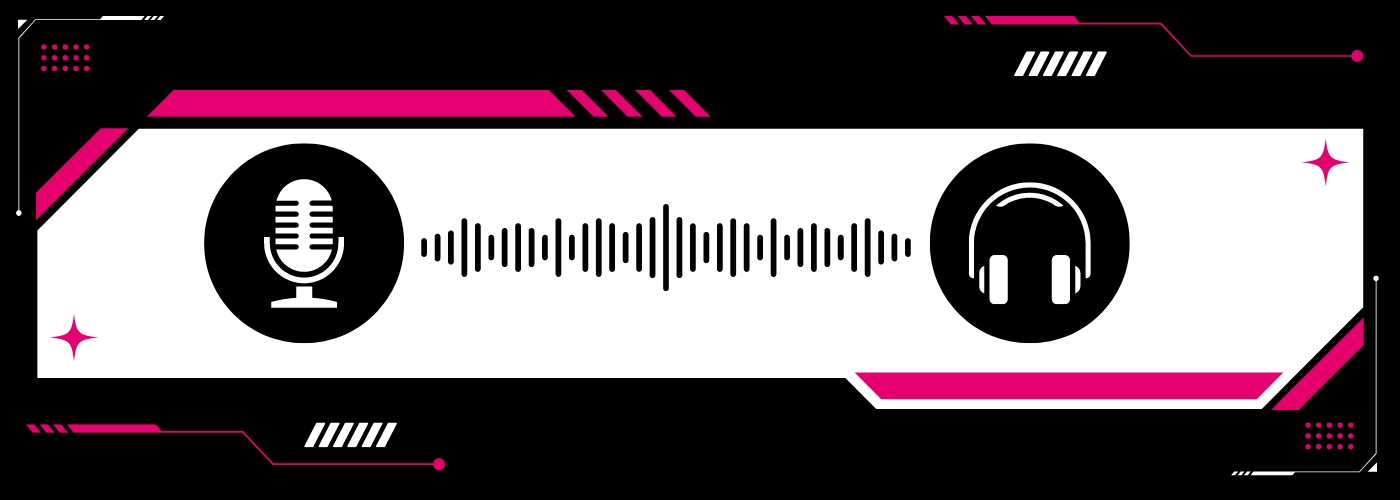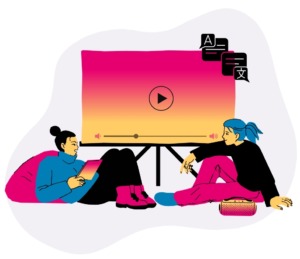What Is Dubbing? Everything You Need to Know About Dubbing Videos
Updated: May 9, 2025
Experience 3Play’s Revolutionary Dubbing Service On Your Content
Dubbing is a common practice in the film and video industry, yet many people are still unsure of exactly what it is. That’s because dubbing preferences vary significantly by country and are shaped by the cultural landscape. It also means that diving into the world of dubbing goes well beyond how it’s made.
In this blog, we’ll discuss the history and cultural aspects of dubbing, what makes it stand out, and how it’s created. Ultimately, we’ll answer the question that has many scratching their heads – exactly what is dubbing?
What is Dubbing?
Dubbing is a vital aspect of globalizing content. It’s a localization method that allows global audiences to consume media in their native or preferred language.
The dubbing process involves replacing the original dialogue in a film, television show, or short-form video with a translated version in a different language, allowing viewers to hear the dialogue in their preferred language.
Dubbing is different than subtitling, which provides a text representation of the original audio and lets viewers read the dialogue in their native language while still hearing the content’s original language.
If you’re wondering where you can find dubbed content, it’s everywhere. Look no further than your Netflix account. There, you’ll find popular foreign content such as Dark (German), Money Heist (Spanish), and Squid Game (Korean). All feature English dubs over the original language tracks, allowing English speakers to hear the popular series in their native language.
So, what is dubbing? Next time someone asks, tell them it’s a powerful way to make video content more accessible to people around the globe.
Dubbing Preferences in the Global Market
Speaking of around the globe, preferences for subtitling vs. dubbing vary internationally.
Unique preferences for dubbing styles differ by region, reflecting cultural norms and audience expectations. Well-executed dubbing seeks to embrace those cultural preferences, enhance audience engagement and immersion, and foster a deeper connection with the story and characters.
What causes the variation in dubbing preferences globally?
A Brief History of Dubbing
Most international dubbing and subtitling preferences were established by the end of World War II and haven’t changed much since. At a time where the majority of the world’s popular entertainment came from Hollywood, dubbing established itself as the main method of localizing films for France, Italy, Germany, and Spain. Since dubbing was so costly, it made economic sense that Hollywood prioritized dubbing for “Europe’s four biggest non-English-speaking markets.”
Beyond economic motivators and historical context, cultural factors such as English language education, viewing preferences, and dubbing availability and quality all impact how people from different countries prefer to engage with foreign content.
Well-executed dubbing is known for accurately capturing the cultural nuances of language, such as humor and cultural references. This results in a viewing experience that closely mirrors the original language content.
Data from recent years shows us dubbing and subtitling preferences by country.
Countries that prefer dubbing:
- Germany
- Italy
- France
- Brazil
- Spain
Countries that prefer subtitling:
- United States
- United Kingdom
- India
- China
- Japan
Learn about 3Play’s human-in-the-loop AI Dubbing solution
Regardless of cultural expectations, media producers stand much to gain from dubbing and subtitling their content. Utilizing both ensures that you’re catering to global variations in content consumption preferences. In other words, it means you’re broadening your global reach.
The Dubbing Process
Dubbing involves translating the original script, casting voice actors, recording dialogue, and syncing it with the video to ensure accuracy and synchronization. It should fit seamlessly into the video, feel natural, and deliver an immersive experience for viewers.
The key to a successful dubbing output is to portray the emotion and tone of the original audio. Creating traditional dubbing tracks requires extensive planning to create a quality result.
Traditional Dubbing and Other Methods
The traditional dubbing process is an established dubbing method in the media industry. It is often a lengthy, manual, and expensive process, requiring creating a script, hiring voice talent, recording the dubbing track, post-production editing, and publishing. Traditional dubbing is commonly used for long-form, cinematic content as high-profile production studios often possess the budget, resources, and expertise to produce traditional dubs.
Traditional dubbing isn’t the only way to dub content. The growing capabilities of artificial intelligence (AI) have introduced innovations and methods for dubbing content. AI Dubbing or automated dubbing uses advances in artificial intelligence and machine learning algorithms to automate critical dubbing steps, while also allowing for human oversight. This process ensures a high quality output at a fraction of the cost.
Both traditional dubbing and AI dubbing are valid options, and there are advantages and challenges to consider for both methods.
Understanding Dubbing Lingo
At this point, we’ve answered the question, “What is dubbing?” However, other related dubbing terms will enhance your knowledge of the subject.
The Different Dubbing Types
Dubbing, as a general term, completely replaces the audio track of the original performance with a new language and fully captures the emotion and tone of the original content.
There are a few different types of dubbing: lip-sync dubbing, voice replacement dubbing, and voiceover. While people may use these words interchangeably, they are different.
Voice Replacement Dubbing
Voice replacement dubbing replaces the original audio with a different language. However, it doesn’t perfectly match the mouth movements of the people on screen. Voice replacement dubbing is still well-timed with the original content.
Lip-Sync Dubbing
On the other hand, lip-sync dubbing closely matches lip movements of the people on screen, further enhancing the realism of dubbed content and allowing the viewing experience to feel unimpeded.
Voiceover
Voiceover is when a person is narrating or describing what’s on screen, and it’s clear to the viewer that the voiceover is separate from the audio track. The voiceover can be in the content’s original language or can be translated into another language. In this scene from Friends, you can hear each of the character’s train of thought in the form of an off-screen voiceover while the character’s actions continue on screen.
Each of these dubbing use cases has their benefits. Choosing voiceover, lip-sync dubbing, or voice replacement dubbing depends on the experience you want to convey to your audience.
AI Dubbing
AI dubbing utilizes artificial intelligence algorithms to automate certain aspects of the dubbing process, such as synthetic voice creation and translation. It allows for greater affordability and flexibility than traditional dubbing. One challenge in this space is that solutions that use only AI throughout the entire process yield low-quality dubs more often than not.
As AI usage becomes more prevalent in the AI dubbing space, humans (ideally native speakers) must be part of the language dubbing process for quality and cultural sensitivity purposes.
Human-in-the-Loop Dubbing
Human-in-the-loop is a process used in AI dubbing where AI technology and humans perform jointly to optimize results. Rather than leaving dubbing to the unreliable quality of AI-only solutions, the human-in-the-loop process ensures accurate transcreation. Transcreation is translating content while maintaining the original intent, style, and tone of the message.
Humans play a crucial role in dubbing by providing artistic interpretation, emotional expression, and quality control throughout the process. AI dubbing processes that incorporate human-in-the-loop will inevitably provide greater depth and authenticity to dubbed content, capturing the nuances of tone, emotion, and cultural context.
Discover AI Dubbing at 3Play →
The Benefits of Dubbing Your Video Content
Now that we’ve answered the question ‘What is dubbing?” you may be wondering if it’s right for your content. Your viewers will find value in dubbed content for the following reasons:
- It portrays the emotion and tone of the original audio.
- It allows them to immerse themselves in the content rather than read subtitles.
- It helps people who struggle with reading or cannot read.
- It enables multitasking while listening to content.
Ultimately, dubbing provides the opportunity to reach new global markets. If your goal is to grow your audience and monetize your content, dubbing is a tool that will help you accomplish just that.
Ready to Globalize Your Video Content?
Dubbing is essential for making video content accessible to global audiences and enhancing cross-cultural understanding. Dubbing and subtitling are two primary localization techniques, each with its benefits and challenges, while human-in-the-loop AI solutions offer opportunities for innovation in dubbing.
As the video content market becomes more saturated, dubbing is a valuable tool brands can use to differentiate and further monetize their content globally.
Are you ready to level up your video content and go global?
3Play Media has provided thousands of our customers with high-quality, accurate localization services. As a one-stop, full-service video accessibility company, 3Play Media offers localization services, including AI Dubbing, as a seamless addition to your other video accessibility needs. Learn more:









